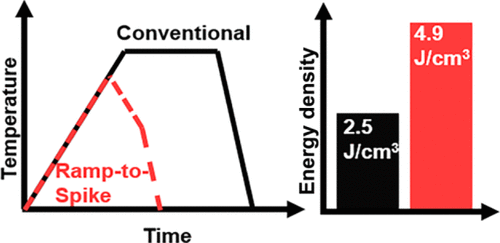当前位置:
X-MOL 学术
›
ACS Appl. Mater. Interfaces
›
论文详情
Our official English website, www.x-mol.net, welcomes your feedback! (Note: you will need to create a separate account there.)
Enhanced Energy Storage Performance of Sodium Niobate-Based Relaxor Dielectrics by a Ramp-to-Spike Sintering Profile.
ACS Applied Materials & Interfaces ( IF 9.5 ) Pub Date : 2020-06-25 , DOI: 10.1021/acsami.0c08737 Letao Yang 1 , Xi Kong 1 , Zhenxiang Cheng 1 , Shujun Zhang 1
ACS Applied Materials & Interfaces ( IF 9.5 ) Pub Date : 2020-06-25 , DOI: 10.1021/acsami.0c08737 Letao Yang 1 , Xi Kong 1 , Zhenxiang Cheng 1 , Shujun Zhang 1
Affiliation

|
Sodium niobate (NaNbO3)-based lead-free ceramics have been actively studied for energy storage applications because of their antiferroelectric and/or relaxor features achieved in modified systems. The P–E loops of NaNbO3-based ceramics are usually hysteretic because of the existence of a metastable ferroelectric phase at room temperature. In this study, by introducing aliovalent cations and A-site vacancies, the relaxor characteristics are greatly enhanced in (Na1–2xBix)(Nb1–xZrx)O3 ceramics, leading to a high energy storage efficiency of above 90%. In addition, sintering aid CuO and a special ramp-to-spike sintering profile were employed to decrease the sintering temperature and reduce the grain size. The modified ceramic exhibits improved insulating properties and hence a higher breakdown strength, leading to a high recoverable energy density of 4.9 J/cm3 and a high energy efficiency of 88% at 430 kV/cm. The ceramic also exhibits satisfactory temperature stability over a wide temperature range from 25 to 125 °C and charge–discharge performance, making it a promising candidate for high-power dielectric energy storage applications.
中文翻译:

通过斜波到尖峰烧结轮廓增强了基于铌酸钠的弛豫电介质的储能性能。
由于铌酸钠(NaNbO 3)基无铅陶瓷的抗铁电和/或弛豫特性在改进的系统中得到了应用,因此已经积极地研究了其在能量存储方面的应用。基于NaNbO 3的陶瓷的P – E环通常是滞回的,因为在室温下存在亚稳态的铁电相。在这项研究中,通过引入铝价阳离子和A位空位,在(Na 1–2 x Bi x)(Nb 1– x Zr x)O 3中大大增强了弛豫特性。陶瓷,导致90%以上的高储能效率。此外,采用了烧结助剂CuO和特殊的坡道至尖峰烧结轮廓来降低烧结温度并减小晶粒尺寸。改性陶瓷表现出改善的绝缘性能,因此具有更高的击穿强度,导致在430 kV / cm时具有4.9 J / cm 3的高可回收能量密度和88%的高能效。陶瓷还具有在25至125°C的宽温度范围内令人满意的温度稳定性以及充放电性能,使其成为大功率介电储能应用的有希望的候选者。
更新日期:2020-07-22
中文翻译:

通过斜波到尖峰烧结轮廓增强了基于铌酸钠的弛豫电介质的储能性能。
由于铌酸钠(NaNbO 3)基无铅陶瓷的抗铁电和/或弛豫特性在改进的系统中得到了应用,因此已经积极地研究了其在能量存储方面的应用。基于NaNbO 3的陶瓷的P – E环通常是滞回的,因为在室温下存在亚稳态的铁电相。在这项研究中,通过引入铝价阳离子和A位空位,在(Na 1–2 x Bi x)(Nb 1– x Zr x)O 3中大大增强了弛豫特性。陶瓷,导致90%以上的高储能效率。此外,采用了烧结助剂CuO和特殊的坡道至尖峰烧结轮廓来降低烧结温度并减小晶粒尺寸。改性陶瓷表现出改善的绝缘性能,因此具有更高的击穿强度,导致在430 kV / cm时具有4.9 J / cm 3的高可回收能量密度和88%的高能效。陶瓷还具有在25至125°C的宽温度范围内令人满意的温度稳定性以及充放电性能,使其成为大功率介电储能应用的有希望的候选者。



























 京公网安备 11010802027423号
京公网安备 11010802027423号